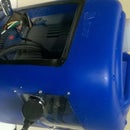Introduction: A Quick RGB Led From Waste
I needed an RGB LED for a tutorial I was following for Arduino. LESSON 13: Controlling an RGB LED with Arduino - YouTube I didn't want buy one and then have to wait for it to arrive. Hence, I decided to make one myself. I had some offcuts from a LED strip and decided to investigate if it was possible to use them.
You need to be quite good at soldering. However, I am not an expert and managed quite well.
Attention! The soldering iron gets very hot and can cause serious burns. Read the manufacturer instructions carefully
before using.
I accept no responsibility for harm or damage caused while you are doing this instructable.
Supplies
A piece of breadboard.
three 390 Ohm resistors
Pin header connectors
wire cutter
fine tip soldering iron and some soldering paste / flux
Third hand soldering station
RGB Led or piece of LED strip
multimeter (you can find very cheap ones at most DIY shops)
Step 1: Retrieving the RGB LED
I used a piece of LED strip that I had lying around. Remove the transparent protective layer. Sometimes the protective layer can become brittle and so it is more difficult to remove.
Ease the transparent layer away for the copper strip. Be careful around the LED and soldered points. You need to expose at least three LED lights so you can choose the best one.
Step 2: Checking the LED
On the same strip, there can be LED's with common positive contacts.
You need to find one with separate positive and separate negative contacts. You also need to know which side is negative and which is positive.
Using a multimeter, set it for testing diodes (see photo) Put the black probe on one of the LED pins, on one side of the LED and the red probe on one of the LED pins on the other side of the LED. If the LED lights then the side of the black probe is negative. If not then the opposite side is negative. In this case, swap probes and make sure the LED lights up.
Check all three LEDs work by moving the probes to each pair of pins in turn.
If you leave the positive probe on one pin and the different LED's light up by just moving the black probe, then the positive is common and the LED is not suitable.
Once you have determined which side is negative and which is positive. Mark which side is which, with a permanent marker, and cut the LED from the strip.
Trim down to approx. 4-5mm around the LED.
Step 3: Attach the LED
Cut a piece of breadboard 50mm x 30mm and glue the LED to the top surface of the breadboard. I used super glue and positioned it in the middle and approx. 5mm from one end. The positive pins should be facing away from the edge.
Step 4: Soldering the Positive Pins
You need three resistors. I used 390-Ohm resistors because I had them already. However, you can also calculate the resistor needed. There are various calculators on internet and you can find the data sheet for these type of LED lights too (I uploaded an example of one). You can also follow the tutorials by Paul McWhorter, who explains this very well. A link can be found in my introduction.
Start by inserting the wire of each of the 3 resistors, from the top side of the breadboard. You need to insert each one, in the third hole away from the LED (see photos)
Next, turn the board over and (skipping a hole) loop each wire back up, from the bottom side, into the nearest hole to the solder point of each positive pin of the LED. see photo
Insert enough of the wire so that it just reaches the solder point on the top side.
The wires on the other sides of the resistor should be inserted down into the nearest hole and then bent towards the other end of the breadboard. The resistors should now be parallel to each other.
Now the difficult part. I used a "third hand soldering station" to hold the breadboard and a fine tip soldering iron.
Put some soldering flux onto the solder points of the LED and then, heating with the soldering iron briefly, put a drop of solder on each pin of the LED.
Tin the wires of the resistors and bend them onto the solder points.
Hold each wire in place with a pair of tweezers and touch the wire with the tip of the soldering iron until the wire is soldered in place. Hold the wire in place until the solder is cool. Repeat for each wire.
Take the strip of header pins and cut off a section of five pins.
Counting from one end, cut off the fourth pin. This is to create a space and separate the positive pins form the negative one.
Use masking tape to holder the strip of pins to the top surface of the breadboard while you solder it from the other side.
Turn the breadboard over and proceed to solder each pin to the copper contacts underneath.
Then solder a wire, from each of the resistors to one of the 3 positive pins. The fifth negative pin should have nothing attached yet.
I have included a diagramme. It is the first electrical diagramme I have ever drawn so if there are any mistakes, let me know.
Attachments
Step 5: Soldering the Negative Pin
Add some soldering flux to the negative pins of the LED and, heating with the soldering iron briefly, add a drop of solder
Push a copper wire (0.8mm diam.) from the bottom of the breadboard and to one side of the negative pins of the LED. Make sure it is on the same side as the fifth (negative) header pin too!
Turn the breadboard over, tin the end of the copper wire and bend it so that it bridges the three negative LED pins together.
Hold the copper wire down onto the negative pins with tweezers.
Touch the copper wire with the soldering iron until the solder starts to flow.
Remove the soldering iron and continue to hold the copper wire in place till the solder cools.
Make sure the copper wire is soldered well onto the three negative pins.
ATTENTION! Do not hold the soldering iron on the LED for too long or the LED could be damaged.
Turn the breadboard over and bend the other end of the copper wire towards the header pins and solder it too the fifth (negative) pin. Trim off any excess wire.
I then used Iso Propyl alcohol to remove the flux from the solder points.
Now test the LED to make sure it still works!
Use a 9V battery to and connect a wire from the negative terminal (on the battery) to the negative (fifth) header pin.
Connect a wire from the positive terminal (on the battery) to each of the positive header pins in turn. A different colour should come on for each pin. Mark which pin corresponds to which colour (RGB).
For best results, it is best to fit a light diffuser. I had one, which I salvaged, but the ball from a roll-on deodorant is also a good diffuser. You can cut it in half / or cut a spherical cap and glue it over the LED.

Participated in the
Make it Glow Contest












